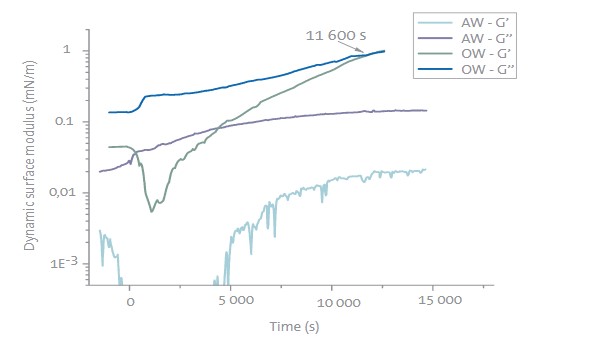
Interfacial rheology studies the rheology of molecular layers. Whereas rheology studies the bulk properties of the liquid, interfacial rheology looks at the 2-dimensional interface where molecules are trapped. The same measurement modes used in bulk rheology are also meaningful in interfacial rheology, including amplitude and frequency sweep, and time-dependent measurement.
Amplitude sweep measurements in rheology are a crucial tool for understanding the viscoelastic behavior of complex fluids and soft materials. This technique involves subjecting an interface to oscillatory stress at varying strain amplitudes with constant frequency while monitoring its response. By systematically increasing the strain amplitude, researchers can observe how the material's properties evolve as a function of strain amplitude. An amplitude sweep is often performed before any other measurement to find the linear viscoelastic (LVE) region.
 The result of the amplitude sweep is typically presented in a plot with a stain on the x-axis and elastic (G‘) and viscous (G’’) modulus on the y-axis; both in logarithmic scale. The linear area in the curve is called a linear viscoelastic region which indicates an area where the measurements can be done without destroying the film structure
The result of the amplitude sweep is typically presented in a plot with a stain on the x-axis and elastic (G‘) and viscous (G’’) modulus on the y-axis; both in logarithmic scale. The linear area in the curve is called a linear viscoelastic region which indicates an area where the measurements can be done without destroying the film structure
Frequency sweep measurements are a fundamental technique in rheology for characterizing the viscoelastic properties of materials across a range of frequencies.  During a frequency sweep, a sample undergoes oscillatory deformation at various frequencies while the stress amplitude remains constant. This method allows researchers to probe how a material responds to different rates of deformation, providing valuable insights into its dynamic mechanical behavior. Frequency and surface modulus are plotted both on a logarithmic scale.
During a frequency sweep, a sample undergoes oscillatory deformation at various frequencies while the stress amplitude remains constant. This method allows researchers to probe how a material responds to different rates of deformation, providing valuable insights into its dynamic mechanical behavior. Frequency and surface modulus are plotted both on a logarithmic scale.
To evaluate time-dependent behavior, measurements are done by keeping both amplitude and frequency constant throughout the measurement. This measurement mode allows following the film formation in real time. This can give information on the kinetics of film formation.

Interfacial rheology has additional parameters as the interfacial layer can have different surface pressures. One common measurement to conduct is the surface modulus as a function of surface pressure. This type of measurement can be done with the interfacial shear rheometer with the Langmuir trough.

If you are interested in learning more about interfacial rheology, please watch the webinar through the link below.
Emulsions are dispersed systems of two immiscible liquids such as oil and water. Interfacial rheology measurements predict emulsion and foam stability.
Pickering emulsions utilize solid particles to stabilize the interface between the two immiscible liquids
International Congress on Interfacial Rheology was held in Athens from the 29th of July to the 4th of August 2023.
Foam stability refers to the ability of a foam to maintain its structure and resist collapse over time.
In this blog post, the most common interfacial shear rheology methods are reviewed.
Interfacial rheology studies the response of the interfacial layer to the external stimuli at air-liquid or liquid-liquid interfaces.
Interfacial shear rheology at the gas-liquid or liquid-liquid interface is relevant in a wide range of applications where foams and emulsions are used.
Interfacial rheology is a special branch of rheology that involves studying the unique two-dimensional systems formed at interfaces.
